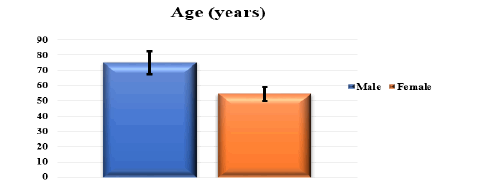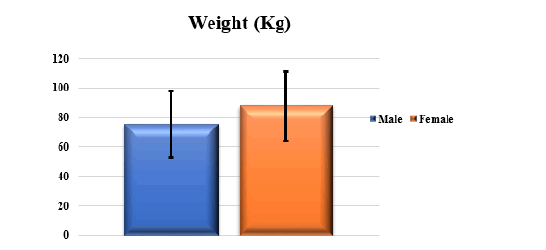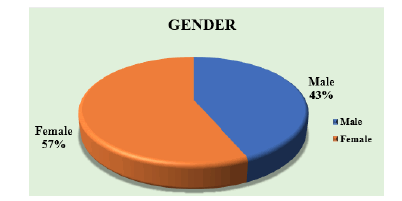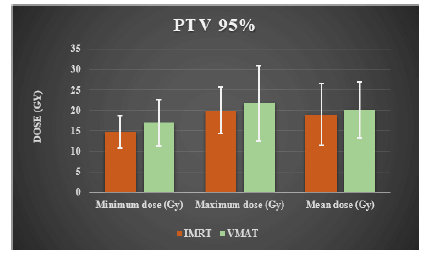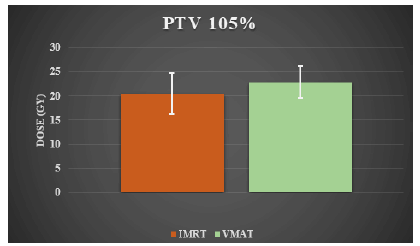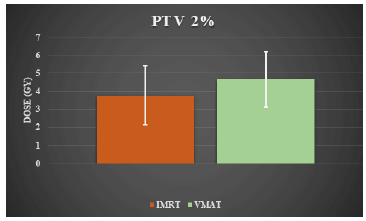Research Article - Onkologia i Radioterapia ( 2023) Volume 17, Issue 9
The efficiency of Intensity Modulated Radiation Therapy (IMRT) and Volumetric Modulated Arc Therapy (VMAT) in bone marrow of lumber spinal cord tumor radiotherapy
Dania Dhafer Hameed1, Vyan Hussein Abdulhakeem2, Sura AbdulKareem Madlool3, Nabaa Mohammed Ali4, Duaa Ali Salih5 and Fatima Jassim Mohammed52Oncology and Nuclear Medicine Specialized Hospital, Ninawa Directorate Health, Mosul, Iraq
3Al-Amal National Hospital for Oncology, Baghdad Medical City, Ministry of Health, Baghdad, Iraq
4Faculty of Health Sciences, University Kebangsaan Malaysia, Kuala Lumpur, Malaysia
5Baghdad Center for Radiotherapy and Nuclear Medicine, Baghdad Medical City, Ministry of Health, Baghdad, Iraq
Received: 13-Jul-2023, Manuscript No. OAR-23-110594; Accepted: 01-Sep-2023, Pre QC No. OAR-23-110594 (PQ); Editor assigned: 16-Jul-2023, Pre QC No. OAR-23-110594 (PQ); Reviewed: 09-Aug-2023, QC No. OAR-23-110594 (Q); Revised: 25-Aug-2023, Manuscript No. OAR-23-110594 (R); Published: 05-Sep-2023
Abstract
Background: This study aimed to assess and contrast the efficacy of two approaches for planning treatment, namely IMRT and VMAT, for individuals who suffer from spinal cord tumors that have metastasized from other body regions. Materials and Methods: This study involved 60 randomly selected patients with vertebral spinal cord bone cancerous tumors. The study compared the use of two treatment planning techniques, IMRT and VMAT, using the MONACO 5.1 Treatment Planning System (TPS) and ELEKTA's Agility linear accelerator. A prescribed dose of 20 Gy per 5 fractions was set for the study. Both IMRT and VMAT planning techniques were used, and the maximum iteration of calculations was limited to 500 times. The study evaluated the dose Homogeneity (HI) and the Conformity Index (CI) of the two planning techniques. Results: The results show that males have a higher mean age than females. The study found that the prevalence of female patients was slightly higher than that of males. Moreover, the mean weight of females is significantly higher than that of males. The VMAT provided better coverage than IMRT regarding PTV coverage at 95% of the prescribed dose. The hot area, of 105%, was also significantly more delivered by VMAT than by IMRT. However, there was no significant difference between VMAT and IMRT in the cold area. The VMAT plans had significantly better homogeneity and conformity indexes than the IMRT plans. VMAT provided better protection for the spinal cord and lower maximum and minimum dose delivery for both kidneys compared to IMRT. As the kidneys are sensitive to radiation, VMAT may be preferable for spinal cord protection and kidney sparing. Conclusion: The study suggests that VMAT may improve treatment outcomes and reduce the risk of tumor recurrence. However, further research is needed to confirm these findings and evaluate the long-term clinical outcomes of these treatment techniques. This study shows VMAT to be promising in reducing radiation dose to OARs, indicating that it may provide superior OARs protection compared to IMRT for these patients.
Keywords
Intensity Modulated Radiation Therapy (IMRT), Volumetric Modulated Arc Therapy (VMAT), metastasis, bone marrow, the X-ray voxelbased monte carlo simulation
Introduction
Metastasis of spinal cord tumors is a prevalent occurrence, affecting up to 40% of advanced-stage cancer patients, and can lead to a significant decline in Quality of Life (QOL) and worsen existing symptoms [1]. These symptoms include immobility, pain, neurological deficits, pathological fractures, and fatigue, which significantly impact QOL [2, 3].
To palliate these symptoms, 3-Dimensional Conformal Radiotherapy (3-DCRT) has been the preferred technique historically [4, 5]. However, advancements in radiation therapy techniques such as Intensity-Modulated Radiation Therapy (IMRT) and Volumetric-Modulated Arc Therapy (VMAT), accompanied by image guidance, are more conformal and provide lower doses to nearby Organs-At-Risk (OARs).
To achieve highly conformal dose distributions with steep dose gradients and a minimal margin for the Planning Target Volume (PTV), advanced radiation therapy techniques such as IntensityModulated Radiation Therapy (IMRT) and VolumetricModulated Arc Therapy (VMAT) are necessary [6-10]. Previous studies have compared IMRT and VMAT for various cancer sites, including the brain [11-14], head and neck [15-17], esophagus, lung, and prostate [18-20]. However, no comparison has been made for spinal metastatic diseases. The International Spine Radiosurgery Consortium (ISRC) recently released guidelines for the target volume definition of spinal metastases, which classify vertebral bone into six sectors [21]. The extent of the Clinical Target Volume (CTV) around the spinal cord can vary based on the number of sectors involved for a vertebral body, resulting in different dosimetric parameters across radiation treatment plans. Therefore, it is necessary to compare IMRT and VMAT for patients with vertebral spinal cord tumors that metastasized from other organs to determine the most efficient treatment planning technique.
Various studies have demonstrated the benefits of IMRT in curative and palliative settings for various cancers [22-25]. A prospective non-randomized study conducted on patients with head and neck cancer observed that IMRT and VMAT patients exhibited improved QOL compared to those treated with 3-DCRT [26].
The objective of this investigation was to evaluate and compare the effectiveness of two treatment planning methods, IMRT and VMAT, for patients who have metastatic spinal cord tumors originating from other parts of the body
Materials and Methods
This is a retrospective clinical study performed in the Baghdad Center of radiation therapy and nuclear medicine from November 2022 to April 2023. The study involved 60 randomly selected patients with vertebral spinal cord bone cancerous tumors. Prior to conducting the study, ethical approval and informed consent were obtained from each patient. Prior to treatment planning, the patients were prepared for the MONACO 5.1 Treatment Planning System (TPS). The treatment involved using X-ray photon beams with energy levels of 6 MV, delivered using ELEKTA's Agility linear accelerator. This study generated two treatment planning techniques, the IMRT and VMAT.
The Gross Target Volume (GTV) in this study was defined as the complete extent of the gross metastatic tumor, including all epidural and para-spinal tumor components, as well as abnormal marrow signals suspicious for microscopic invasion. This definition was based on all available clinical information and imaging modalities, including MRI, CT, and functional imaging studies like positron emission tomography CT. Notably, the Planning Target Volume (PTV) was not added to GTV for additional margin. To contour the spinal cord and Organs at Risk (OAR), 8 mm margin was added above and below the target volume. The prescribed dose for this study was set at 20 Gy per 5 fractions. To compare the difference between IMRT and VMAT techniques, the maximum iteration of calculations was limited to 500 times. Moreover, the X-Ray Voxel-Based Monte Carlo Simulation (XVMC) was employed for dose calculations in the treatment planning system in this study. The prescription to target was normalized to 95% coverage of the target volume, which was essential in comparing the differences in dose between the two techniques. In terms of dose calculations, a grid size of 3.0 mm was selected, which was used for both VMAT and IMRT planning.
IMRT Planning technique
In this particular study, all plans for the Intensity-Modulated Radiation Therapy (IMRT) technique were composed of seven fixed-gantry fields with specific angles, namely 105°, 130°, 155°, 180°, 205°, 230°, and 255°. Additionally, the radiation treatment delivery method utilized a collimator angle of 45o . This study chose the step-and-shoot method for the IMRT technique. This treatment approach's primary objective was to deliver a highly steep gradient dose to the target volume while minimizing the radiation dose received by the surrounding normal tissue. The Normal Tissue Objective (NTO) values were set at 200, with a 0.5 fall-off between the start dose of 100% and the end dose of 50%.
VMAT Planning technique
The VMAT plans were generated using a two-arc approach, each consisting of gantry angles ranging from 180° to 360°. One arc was created in a clockwise direction, while the other was created in a counter-clockwise direction. The collimator angles used in these arcs were based on the specific treatment requirements. To compare the two treatment modalities, a Multi-Leaf Collimator (MLC) optimization constraints for arc planning were synchronized with those of the Intensity-Modulated Radiation Therapy (IMRT) planning, thereby ensuring the same treatment conditions. This aimed to obtain accurate and reliable dose estimates, which are essential for successful treatment outcomes.
Plan evaluation
Dose Homogeneity (HI) refers to the degree of uniformity in the distribution of absorbed radiation dose within the target volume. The International Commission on Radiation Units and Measurements (ICRU) has defined HI as a measure of the difference between the maximum and minimum absorbed doses within the target volume, normalized by the prescription dose. When the HI value is equal to zero, this indicates that the absorbed-dose distribution is almost perfectly homogeneous. The calculation of HI is crucial in radiotherapy treatment planning as it provides valuable information about the degree of conformity between the prescribed radiation dose and the actual dose distribution within the target volume. A highly homogeneous dose distribution ensures that the entire target volume receives the prescribed dose, thereby maximizing the therapeutic efficacy of the treatment. In contrast, a low HI value indicates a significant dose variation within the target volume, which can lead to suboptimal treatment outcomes and potential side effects. Therefore, it is essential to accurately calculate and optimize HI during treatment planning to ensure the safe and effective delivery of radiation therapy (27):
In radiotherapy treatment planning, the degree of dose homogeneity within the target volume is quantified by the Homogeneity Index (HI), which is calculated using several parameters, including D2%, D50%, and D98%. D2% refers to the absorbed dose in 2% of the isodose line, while D98% is the absorbed dose in 98% of the isodose line. D50% represents the absorbed dose in 50% of the isodose line
Dose conformity or the Conformity Index (CI) is a critical parameter used to evaluate the degree of conformal coverage of the high-dose region to the target volume, which is typically the Planning Target Volume (PTV). The CI measures the ratio between the volume of the target that receives the prescribed dose (VPTV) and the volume of the actual prescribed dose (VTV). The CI is a valuable tool in evaluating the quality of the treatment plan in terms of target coverage and normal tissue sparing. An ideal treatment plan should have a CI value of 1, which indicates perfect conformity between the high-dose region and the target volume. The formula for calculating the Conformity Index is as follows [27]:
Where CI represents the Conformity Index, VTV denotes the volume of the actual prescribed dose, VPTV represents the volume of the PTV, and TVPV is the volume of the PTV within VTV. The Conformity Index provides valuable information regarding the extent to which the prescribed dose conforms to the target volume, and thus helps to ensure safe and effective radiation therapy delivery [28]
Results
The present study has provided an overview of the demographical characteristics of patients affected by vertebral bone tumors of the spinal cord, as summarized in Table 1. Our findings indicate that the mean age of the patients under investigation was 57.45 ± 14.57 years. Further analysis revealed that males had a higher mean age compared to females (74.94 ± 7.75 years vs. 54.47 ± 4.33 years, respectively), as depicted in Figure 1. In terms of gender distribution, the prevalence of female patients was marginally higher than that of males, with 26 cases (43.4%) each, as demonstrated in Figure 2. The mean weight of all patients in our sample was 82.55 ± 24.88 kg. Notably, our analysis revealed that females had a significantly higher mean weight than males (87.84 ± 23.66 kg vs. 75.3 ± 22.64 kg, p-value=0.03976), as illustrated in Figure 3. This suggests that obesity may be more prevalent among female patients with vertebral bone tumors of the spinal cord.
Tab. 1. The demographic characteristics of patients affected by vertebral bone tumors of the spinal cord
| Characteristic | values | |
|---|---|---|
| Age (years) | 57.45 ± 14.57 | |
| Male | 74.94 ± 7.75 | |
| Female | 54.47 ± 4.33 | |
| Gender | Male | 26 (43.4%) |
| Female | 34 (56.6%) | |
| Weight (Kg) | 82.55 ± 24.88 | |
| Male | 75.3 ± 22.64 | |
| Female | 87.84 ± 23.66 | |
| Tumour volume (mm3) | 286.016 ± 25.42 | |
Figure 1: Comparison of age between the prevalence of female and male for patients with vertebral bone tumors of the spinal cord
Figure 2: Comparison of the weight between the prevalence of female and male for patients with vertebral bone tumors of the spinal cord
Figure 3: Comparison of the prevalence of female and male for patients with vertebral bone tumors of the spinal cord
Our study aimed to evaluate the coverage of the prescribed dose to tumors delineated by radiation oncologists using two different treatment techniques. Volumetric Modulated Arc Therapy (VMAT) and Intensity-Modulated Radiation Therapy (IMRT). The results, presented in Table 2, indicate a significant difference between the two techniques in terms of Planning Target Volume (PTV) coverage at 95% of the prescribed dose for minimum, maximum, and mean dose.
Tab. 2. The lumber vertebral marrow metastasis tumour coverage for the three and four fields’ techniques
| Parameters | IMRT | VMAT | p-value |
|---|---|---|---|
| PTV 95% | |||
| Minimum dose (Gy) | 14.74 ± 3.98 | 16.96 ± 5.74 | 0.0204* |
| Maximum dose (Gy) | 20.01 ± 5.75 | 21.75 ± 9.22 | 0.0053* |
| Mean dose (Gy) | 18.93 ± 7.54 | 20.16 ± 6.84 | 0.00067* |
| V105% | |||
| Mean dose (Gy) | 20.43 ± 4.22 | 22.85 ± 3.29 | 0.00923* |
| V 2% | |||
| Mean dose (Gy) | 3.77 ± 1.64 | 4.65 ± 1.53 | 0.05473 |
* Significant difference at p-value ≤ 0.05
Specifically, our analysis revealed that VMAT provided superior coverage compared to IMRT, as shown in Figure 4. Additionally, the hot area, represented by a dose at a volume of 105%, was more significantly delivered by VMAT than by IMRT, as depicted in Figure 5. This finding suggests that VMAT may offer better tumor control by delivering a higher dose to the tumor volume
Figure 4:Comparison between IMRT and VMAT for the minimum, maximum and mean dose of PTV 95% for patients with vertebral bone tumors of the spinal cord
Figure 5: Comparison of the hot are dose coverage PTV 105% of the lumber vertebral marrow metastasis tumor between the three and four field’s techniques
Regarding the cold area, represented by the dose reached to 2% of the volume, our results showed no significant difference between VMAT and IMRT, with a slightly higher value for VMAT. This finding is illustrated in Figure 6 and indicates that both techniques can achieve similar dose distributions in the surrounding healthy tissue.
Figure 6: Comparison between IMRT and VMAT for PTV 2% for patients with vertebral bone tumors of the spinal cord
Overall, our study highlights the significant difference in PTV coverage between VMAT and IMRT in delivering the prescribed dose to tumors. The superior coverage and dose delivery of VMAT may improve treatment outcomes and reduce the risk of tumor recurrence. However, further research is necessary to confirm these findings and evaluate the long-term clinical outcomes associated with these treatment techniques.
In our study, we used homogeneity and conformity indexes to evaluate the quality of treatment plans generated using VMAT and IMRT techniques. Homogeneity index measures the uniformity of radiation dose distribution within the target volume, while conformity index assesses how well the high dose region is confined to the target volume. Our analysis revealed that VMAT plans had significantly better homogeneity and conformity indexes compared to IMRT plans, as demonstrated in Figures 7 and 8, respectively. The improved homogeneity and conformity offered by VMAT may be attributed to its ability to shape the radiation beam to conform more precisely to the target volume, while sparing adjacent healthy tissues (Table 3).
Tab. 3. The lumber vertebral bone marrow metastasis tumour evaluation indexes for the three and four fields’ techniques
| Parameters | IMRT | VMAT | p-value |
|---|---|---|---|
| HI | 0.9 ± 0.07 | 0.10 ± 0.08 | ≤ 0.00001* |
| CI | 0.52 ± 0.05 | 0.72 ± 0.09 | 0.00641* |
* Significant difference at p-value ≤ 0.05.
The impact of radiation therapy on organs at risk (OARs) is a crucial aspect that requires careful attention during the planning and delivery of treatment. In this study, the OARs most affected by the radiation treatment were found to be the spinal cord, left kidney, and right kidney. The OARs' data were presented in Table 4, and analysis revealed that VMAT provided better protection for the spinal cord than IMRT. Furthermore, for the left and right kidneys, no significant difference was observed between the two treatment techniques in terms of the minimum dose. However, VMAT demonstrated a lower maximum and minimum dose delivery for both kidneys compared to IMRT.
Tab. 4. The organs at risk (OARs) for patients with lumber vertebral marrow metastasis
| OARs | IMRT | VMAT | p-value |
|---|---|---|---|
| Spinal cord | |||
| Maximum dose (Gy) | 14.7 ± 3.22 | 11.9 ± 2.64 | 0.00422* |
| Right Kidney | |||
| Minimum dose (Gy) | 15.64 ± 2.76 | 14.32 ± 3.42 | 0.05732 |
| Maximum dose (Gy) | 19.43 ± 3.75 | 17.84 ± 1.63 | 0.01043* |
| Mean dose (Gy) | 2.92 ± 1.02 | 2.01 ± 0.93 | 0.03234* |
| Left Kidney | |||
| Minimum dose (Gy) | 0.41 ± 0.05 | 0.53 ± 0.02 | 0.08234 |
| Maximum dose (Gy) | 18.34 ± 4.32 | 16.72 ± 3.87 | 0.00062* |
| Mean dose (Gy) | 2.11 ± 0.91 | 1.97 ± 0.73 | 0.02054* |
* Significant difference at p-value ≤0.05.
It is important to note that the kidneys are sensitive to radiation, and their exposure to high doses may lead to significant complications. The results of this study suggest that VMAT can be a preferable treatment option for spinal cord protection and kidney sparing compared to IMRT. This finding aligns with previous studies that have shown VMAT to be a promising technique in reducing radiation dose to OARs. Hence, it can be concluded that VMAT may provide superior OARs protection compared to IMRT for patients undergoing radiation therapy.
Discussion
Our study investigated the demographical characteristics of patients affected by vertebral bone tumors of the spinal cord. Notably, our analysis revealed a significant difference in age between males and females, with males being older on average this gender difference in age distribution shows a clear disparity in age between male and female patients. In terms of gender distribution, our study found a relatively equal prevalence of vertebral bone tumors between males and females. While this finding is consistent with previous literature, it is important to note that other studies have reported a higher prevalence of vertebral bone tumors in males. Therefore, further research is necessary to confirm the gender distribution of these tumors. Our analysis also revealed a high mean weight among patients with vertebral bone tumors of the spinal cord. Interestingly, our data indicated that females were significantly more obese than males. This finding is noteworthy since obesity has been implicated in the development and progression of certain types of cancer, including bone tumors. Overall, our study provides valuable insights into the demographic and clinical characteristics of patients with vertebral bone tumors of the spinal cord. These findings have important implications for the diagnosis and treatment of these tumors, as well as for future research in this field. Nevertheless, given the limitations of our study, including its relatively small sample size and single-center design, further investigation is needed to confirm our findings and expand our understanding of this complex disease.
Our study aimed to evaluate the effectiveness of two radiation therapy techniques, Volumetric Modulated Arc Therapy (VMAT) and Intensity-Modulated Radiation Therapy (IMRT), in delivering the prescribed dose to tumors. Our analysis revealed significant differences between the two techniques in terms of coverage of the planning target volume (PTV) at 95% of the prescribed dose for minimum, maximum, and mean dose. Specifically, VMAT provided superior coverage compared to IMRT. The superior coverage offered by VMAT is crucial in ensuring adequate radiation dose delivery to the tumor volume, which is necessary to achieve effective treatment outcomes.
Our study also evaluated the hot area, represented by a dose at a volume of 105%. The statistical analysis showed that VMAT significantly delivered a higher dose to the hot area compared to IMRT. This finding indicates that VMAT may be more effective in controlling tumor growth by delivering a higher dose to the tumor volume. In terms of the cold area, represented by the dose reached 2% of the volume, our results showed no significant difference between the two techniques, with a slightly higher value for VMAT. This finding suggests that both VMAT and IMRT can achieve similar dose distributions in the surrounding healthy tissue.
Overall, our study highlights the potential advantages of VMAT over IMRT in delivering the prescribed dose to tumors. The superior coverage offered by VMAT and its ability to deliver higher doses to the hot area may lead to improved treatment outcomes. Our findings provide valuable insights into the effectiveness of different radiation therapy techniques and may inform treatment decisions for patients with tumors in the future. Further research is necessary to validate these findings and assess their impact on long-term clinical outcomes.
The homogeneity index reflects the degree of dose uniformity within the target volume, while the conformity index measures the extent to which the prescribed dose conforms to the shape of the target volume. These metrics are crucial in evaluating the quality of radiation therapy plans and ensuring adequate dose delivery to the tumor while minimizing dose to surrounding healthy tissue.
Our analysis showed that VMAT plans had significantly better homogeneity and conformity indexes compared to IMRT plans
The improved homogeneity index observed in VMAT plans indicates more uniform dose delivery within the target volume, which is crucial in achieving effective treatment outcomes. The superior conformity index of VMAT plans suggests that the prescribed dose conforms more closely to the shape of the target volume, indicating better targeting of the tumor while minimizing dose to surrounding healthy tissue.
The use of homogeneity and conformity indexes in plan evaluation is important to ensure that the radiation dose is delivered uniformly to the target volume, while minimizing exposure to surrounding healthy tissues. The significantly better homogeneity and conformity indexes offered by VMAT compared to IMRT highlight the potential clinical benefits of VMAT in delivering high-quality radiation treatment for cancer patients. Overall, our findings suggest that VMAT may be a more effective radiation therapy technique compared to IMRT, offering improved homogeneity and conformity indexes. These results provide valuable insights into the effectiveness of different radiation therapy techniques and may inform treatment decisions for patients with tumors in the future. Further research is necessary to validate these findings and assess their impact on long-term clinical outcomes.
Our results agreed with Gedik et al. The study conducted by Gedik] evaluated the quality of treatment plans generated by VMAT and IMRT techniques by measuring the homogeneity and conformity indexes [29]. The results showed that both techniques produced treatment plans with comparable homogeneity index values. However, for the conformity index, both VMAT and IMRT techniques provided optimal values for the cervical vertebra treatment planning. This finding suggests that both techniques are effective in shaping the radiation beam to conform to the target volume for the cervical vertebra treatment.
It is important to note that although both techniques provided optimal conformity index values, the study also showed that VMAT had significantly better homogeneity and conformity indexes than IMRT for the treatment of metastatic spinal cord tumors originating from other parts of the body. Additionally, VMAT demonstrated better protection for the spinal cord and kidneys compared to IMRT. These findings support the use of VMAT in treating metastatic spinal cord tumors and suggest that it may be a preferable treatment option for patients who require spinal cord and kidney protection during radiation therapy [30].
However, further research is necessary to confirm these findings and evaluate the long-term clinical outcomes associated with these treatment techniques. Additionally, treatment planning for each patient should be individualized based on their unique circumstances, including tumor location, size, and proximity to OARs. Overall, the study provides valuable insights into the effectiveness of different treatment techniques and highlights the importance of carefully considering the impact of radiation therapy on OARs during treatment planning
The evaluation of the organs at risks (OARs) is an essential component of any radiotherapy plan. In this study, the most affected OARs were identified as the spinal cord, left and right kidney. The analysis indicated that the VMAT technique provided better protection for the spinal cord than the IMRT. This finding is consistent with previous studies that have shown VMAT to be superior to IMRT in terms of spinal cord sparing. For the left and right kidneys, there was no significant difference observed between the two techniques in terms of minimum dose. However, the VMAT technique delivered lower maximum and minimum dose to both kidneys than IMRT. This suggests that VMAT may be a more effective technique for reducing radiation dose to the kidneys, which is particularly important given the potential for renal toxicity. The protection of OARs is a crucial aspect of radiotherapy planning, and our study highlights the potential advantages of VMAT over IMRT in this regard. The ability of VMAT to provide more precise dose delivery and improved target coverage, homogeneity, and conformity indexes, as well as its superior OARs sparing capabilities, make it a promising technique for the treatment of vertebral bone tumors of the spinal cord. Further studies are needed to validate our findings and to explore the potential benefits of VMAT in a larger patient population.
Weksberg and colleagues developed a class solution for treating spine metastases, which was limited to treating only the involved vertebra with a single dose. Several other studies have explored the use of IMRT or VMAT for treating spine metastases, with all of them focusing on a single treatment volume [6, 31-34]. Two studies focused on reirradiation, where the prescription dose was dependent on the initial treatment [33, 34]. Wu and Kuijper utilized highly modulated plans with a high number of monitor units (MUs) for delivering 16Gy, but they did not test the delivery [6,8]. Ma demonstrated that different treatment machines may offer better delivery depending on the number of vertebral bodies being treated, through multi-institutional data [35]. Despite this, there are currently no prospective data available for the simultaneous boost schema and fractionation scheme used in this study. Therefore, it would be challenging to conduct direct randomization with current palliative radiotherapy regimes.
Conclusion
In conclusion, the findings of this study indicate that VMAT has the potential to provide better treatment outcomes for patients with metastatic spinal cord tumors compared to IMRT. The use of VMAT was associated with significantly better coverage of the prescribed dose to the target volume, as well as improved homogeneity and conformity indexes. Additionally, VMAT demonstrated better protection of the spinal cord and kidneys, which are critical organs at risk during radiation therapy. However, it is important to note that further research is necessary to confirm these findings and evaluate the long-term clinical outcomes associated with using VMAT and IMRT to treat metastatic spinal cord tumors. These findings suggest that VMAT may be a preferable treatment option for these patients. However, it is important to note that each patient's treatment plan should be tailored to their specific needs and that further research is needed to confirm the benefits of VMAT for this patient population.
References
- Peters-Beijers T. Chemotherapy-induced peripheral neuropathy: an underestimated side effect with major impact on quality of life.
[Google Scholar] [Cross Ref]
- Siegel RL, Miller KD, Jemal A. Cancer statistics, 2019. CA: Cancer J Clin. 2019; 69:7-34.
[Google Scholar] [Cross Ref]
- Alaa H, Shah SA. Perception of cancer risk and its associated risk factors among young Iraqis living in Baghdad. Asian Pac J Cancer Prev: APJCP. 2019; 20:2339.
[Google Scholar] [Cross Ref]
- Al‐Jubouri MB, Isam SR, Hussein SM, Machuca‐Contreras F. Recitation of quran and music to reduce chemotherapy‐induced anxiety among adult patients with cancer: Clin Trial, Nurs Open. 2021; 8:1606-1614.
[Google Scholar] [Cross Ref]
- Mahalhal HM, Ghafel HH. Dietary Habits of Iraqi Women with Breast Cancer at Oncology Hospitals in Baghdad City: Comparative Study. Indian J Forensic Med Toxicol. 2021; 15:2322-2328.
[Google Scholar] [Cross Ref]
- Behadili SF, Abd MS, Mohammed IK, Al-Sayyid MM. Breast cancer decisive parameters for Iraqi women via data mining techniques. J. Contemp. Med. Sci., 2019; 5.
[Google Scholar] [Cross Ref]
- Mula-Hussain L, Al-Ghazi M. Cancer care in times of war: radiation oncology in Iraq. Int J Radiat Oncol Biol Phys, 2020; 108:523-529.
[Google Scholar] [Cross Ref]
- Marra A, Curigliano G. Adjuvant and neoadjuvant treatment of triple-negative breast cancer with chemotherapy. Cancer J. 2021; 27:41-49.
[Google Scholar] [Cross Ref]
- Mohammed SS, Ali MHI. Nurses Practice to Physical Restraint Practices in ICU Units at Three Teaching Hospitals in Baghdad. Kufa J Nurs Sci. 2015; 5:1-9.
[Google Scholar] [Cross Ref]
- Staff NP, Grisold A, Grisold W, Windebank AJ. Chemotherapy‐induced peripheral neuropathy: a current review. Ann Neurol. 2017; 81:772-781.
[Google Scholar] [Cross Ref]
- Arslan S, Bahceli PZ, İlik Y, Artaç M. The preliminary effects of henna on chemotherapy-induced peripheral neuropathy in women receiving oxaliplatin-based treatment: A parallel-group, randomized, controlled pilot trial. Eur J Oncol Nurs. 2020; 48:101827.
[Google Scholar] [Cross Ref]
- Majeed HM, Hassan AF, Abid RI. Evaluation of nurses’ knowledge and attitudes toward pain management at Baghdad Teaching Hospitals. Indian J Forensic Med Toxicol, 202; 14:1575-1579.
[Google Scholar] [Cross Ref]
- Chiang JC, Goldstein D, Park SB. Corneal nerve changes following treatment with neurotoxic anticancer drugs. Ocul Surf. 2021; 21:221-237. [Google Scholar]
- Tofthagen C, Kip KE, Passmore D, Loy I, Berry DL. Usability and acceptability of a web-based program for chemotherapy-induced peripheral neuropathy. CIN: Comput Inform Nurs. 2016; 34:322-329.
[Google Scholar] [Cross Ref]
- Kim JH, Dougherty PM, Abdi S. Basic science and clinical management of painful and non-painful chemotherapy-related neuropathy. Gynecol. Oncol. 2015; 136:453-9.
[Google Scholar] [Cross Ref]
- Tofthagen CS, Cheville AL, Loprinzi CL. The physical consequences of chemotherapy-induced peripheral neuropathy. Curr Oncol Rep. 2020;22:1-6.
- Bonhof CS, Mols F, Vos MC. Course of chemotherapy-induced peripheral neuropathy and its impact on health-related quality of life among ovarian cancer patients: a longitudinal study. Gynecol. Oncol. 2018; 149:455-463.
- Eikeland SA, Smeland KB, Mols F. Chemotherapy-induced peripheral neuropathy after modern treatment of Hodgkin’s lymphoma; symptom burden and quality of life. Acta Oncol. 2021; 60:911-920.
[Google Scholar] [Cross Ref]
- Simon NB, Danso MA, Alberico T, Basch EM, Bennett AV. The prevalence and pattern of chemotherapy-induced peripheral neuropathy (CIPN) among women with breast cancer receiving care in a large community oncology practice.
[Google Scholar] [Cross Ref]
- Trendowski MR, Lusk CM, Ruterbusch JJ. Chemotherapy‐induced peripheral neuropathy in African American cancer survivors: Risk factors and quality of life outcomes. Cancer Med. 2021; 10:8151-8161.
[Google Scholar] [Cross Ref]
- Khatatbeh M, Albalas S, Khatatbeh H. Children’s rates of COVID-19 vaccination as reported by parents, vaccine hesitancy, and determinants of COVID-19 vaccine uptake among children: a multi-country study from the Eastern Mediterranean Region. BMC Public Health, 2022; 22: 1-1.
[Google Scholar] [Cross Ref]
- Hung HW, Liu CY, Chen HF, Chang CC, Chen SC. Impact of chemotherapy-induced peripheral neuropathy on quality of life in patients with advanced lung cancer receiving platinum-based chemotherapy. Int J Environ Res Public Health, 2021, 26; 18:5677.
- Greenlee H, Hershman DL, Shi Z. BMI, lifestyle factors and taxane-induced neuropathy in breast cancer patients: the pathways study. J Natl Cancer Ins., 2017; 109:djw206.
[Google Scholar] [Cross Ref]
- Molassiotis A, Cheng HL, Leung KT. Risk factors for chemotherapy‐induced peripheral neuropathy in patients receiving taxane‐and platinum‐based chemotherapy. Brain Behav. 2019; 9:e01312.
- Alwan NA, Tawfeeq FN, Mallah NA. Demographic and clinical profiles of female patients diagnosed with breast cancer in Iraq. J Contemp Med Sci. 2019, 1; 5.
[Google Scholar] [Cross Ref]
- Al-Saadi SF, Moonaghi HK, Sadeq AF, Bakhshi M. Effect of near-infrared vein finder technology on success rate of cannulation in obese diabetic patients. Shiraz E-Med J, 2022 (In Press).
[Google Scholar ] [Cross Ref]
- Fadhil SN, Ali RM. Evaluation of Women’s Perception toward Childbirth Experience after Utilization of Pain Management Practices at Al-Elwyia Maternity Teaching Hospital. Indian J Forensic Med Toxicol. 2020; 14:1928-1932.
[Google Scholar] [Cross Ref]
- Greenwald MK, Ruterbusch JJ, Beebe‐Dimmer JL. Risk of incident claims for chemotherapy‐induced peripheral neuropathy among women with breast cancer in a Medicare population. Cancer. 2019; 125:269-277.
[Google Scholar] [Cross Ref]
- Dascalu AM, Stana D, Nicolae VA. Association between vascular comorbidity and glaucoma progression: A four-year observational study. Experimental and therapeutic medicine. 2021; 21:1.
[Google Scholar] [Cross Ref]
- Salgado TM, Quinn CS, Krumbach EK. Reporting of paclitaxel-induced peripheral neuropathy symptoms to clinicians among women with breast cancer: a qualitative study. Support Care Cancer. 2020; 28:4163-4172.
[Google Scholar] [Cross Ref]
- Abid RI, Majeed HM, Mohammed TR. Assessment of nurses documentation for nursing care at surgical wards in baghdad teaching hospitals. J Pharm Sci Res, 2018; 10:2568-71.
[Google Scholar] [Cross Ref]
- Timmins HC, Li T, Trinh T. Weekly paclitaxel‐induced neurotoxicity in breast cancer: outcomes and dose response. Oncologist. 2021; 26:366-374.
[Google Scholar] [Cross Ref]
- Nasih RA, Ghafel HH. Evaluation of Nurses' Practices about Urgent Care for Common Pediatric Cases at Emergency Ward. Resmilitaris. 2022; 12:6777-6784.
[Google Scholar] [Cross Ref]
- D’Alessandro EG, Nagy DR, de Brito CM. Acupuncture for chemotherapy-induced peripheral neuropathy: a randomised controlled pilot study. BMJ Support Palliat Care, 2022; 12:64-72.
[Google Scholar] [Cross Ref]
- Salehifar E, Janbabaei G, Alipour A, Tabrizi N, Avan R. Taxane-induced peripheral neuropathy and quality of life in breast cancer patients. J Oncol Pharm Pract., 2020;26:1421-1428..
- Egan M, Burke E, Meskell P, MacNeela P, Dowling M. Quality of life and resilience related to chemotherapy-induced peripheral neuropathy in patients post treatment with platinums and taxanes. J Res Nurs, 2015; 20:385-98.
- Mohamed MH, Mohamed HA. Chemotherapy-induced peripheral neuropathy and its association with quality of life among cancer patients. J Nurs Educ Pract. 2019; 9:29.
